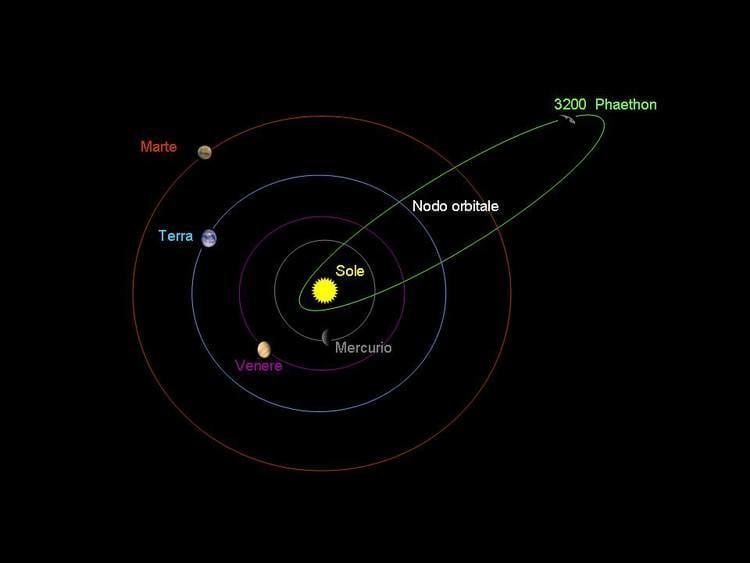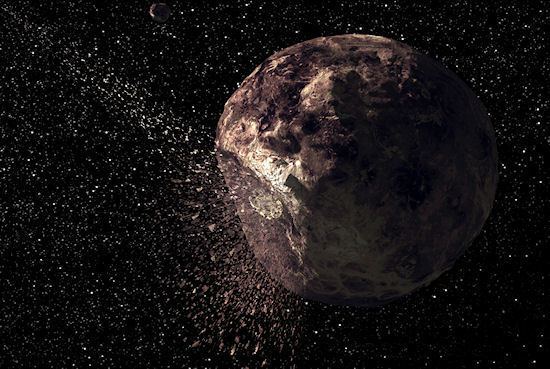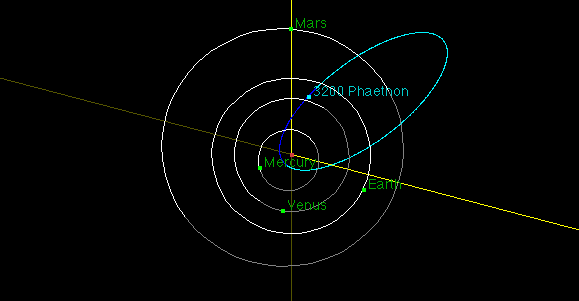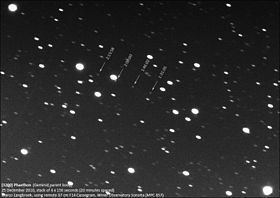Discovery date 11 October 1983 Alternative names 1983 TB Orbital period 524 days Orbital period 1.4 years | Named after Phaëton Observation arc 11,782 days (32.26 a) Orbital period 1.4 years Discovered 11 October 1983 Spectral type B-type asteroid | |
 | ||
Minor planet category Apollo asteroidMercury-crosser asteroidVenus-crosser asteroidEarth-crosser asteroidMars-crosser asteroid Similar Sun, Solar System, 55P/Tempel–Tuttle, (196256) 2003 EH1, Castor | ||
3200 phaethon rock comet the 2014 geminid meteor shower science at nasa
3200 Phaethon (/ˈfeɪ.əθɒn/ FAY-ə-thon, sometimes incorrectly spelled Phaeton) is an Apollo asteroid with an unusual orbit that brings it closer to the Sun than any other named asteroid (though there are several unnamed asteroids, including three numbered ones, with smaller perihelia, e.g. (137924) 2000 BD19). For this reason, it was named after the Greek myth of Phaëton, son of the sun god Helios. It is 5.1 ± 0.2 km (3.17 ± 0.12 mi) in mean diameter.
Contents
- 3200 phaethon rock comet the 2014 geminid meteor shower science at nasa
- rock comet 3200 phaethon
- Discovery
- Orbital characteristics
- Physical characteristics
- Meteor shower
- Recent close approaches
- References

rock comet 3200 phaethon
Discovery

Phaethon was the first asteroid to be discovered using images from a spacecraft. Simon F. Green and John K. Davies discovered it in images from October 11, 1983, while searching Infrared Astronomical Satellite (IRAS) data for moving objects. It was formally announced on October 14 in IAUC 3878 along with optical confirmation by Charles T. Kowal, who reported it to be asteroidal in appearance. Its provisional designation was 1983 TB, and it later received the numerical designation and name 3200 Phaethon in 1985.
Orbital characteristics

It is categorized as an Apollo asteroid, as its semi-major axis is greater than that of the Earth's and its perihelion is less than 1.017 AU (152 million km; 94.5 million mi). It is also suspected to be a member of the Pallas family of asteroids.

Phaethon's most remarkable distinction is that it approaches the Sun closer than any other named asteroid: its perihelion is only 0.14 AU (20.9 million km; 13.0 million mi) — less than half of Mercury's perihelial distance. It is a Mercury-, Venus-, Earth-, and Mars-crosser as a result of its high orbital eccentricity. The surface temperature at perihelion could reach around 1,025 K (750 °C; 1,390 °F).
Physical characteristics
Phaethon is an asteroid with fairly unusual characteristics in that its orbit more closely resembles that of a comet than an asteroid; it has been referred to as a "rock comet". In recent studies performed by NASA's STEREO spacecraft, dust tails have been observed, and in 2010 Phaethon was detected ejecting dust. It is possible that the Sun's heat is causing fractures similar to mudcracks in a dry lake bed.

Phaethon's composition fits the notion of its cometary origin; it is classified as a B-type asteroid because it is composed of dark material. Since its discovery, several other objects were found exhibiting mixed cometary and asteroidal features, such as 133P/Elst–Pizarro.
Meteor shower
Shortly after its discovery, Fred Whipple observed that the "orbital elements of 1983 TB shown on IAUC 3879 are virtually coincident with the mean orbital elements of 19 Geminid meteors photographed with the super-Schmidt meteor cameras". In other words, Phaethon is the long-sought parent body of the Geminids meteor shower of mid-December.
Recent close approaches
Phaethon approached to 0.120895 AU (18,085,600 km; 11,237,900 mi) of Earth on December 10, 2007. On December 10, 2017, it will pass 0.06893 AU (10,312,000 km; 6,407,000 mi) from Earth. Then on December 14, 2093, it will pass 0.0198 AU (2,960,000 km; 1,840,000 mi) from Earth.
When Phaethon came to perihelion in July 2009, it was found to be brighter than expected. During its approach, the STEREO-A spacecraft detected an unexpected brightening, roughly by a factor of two.
